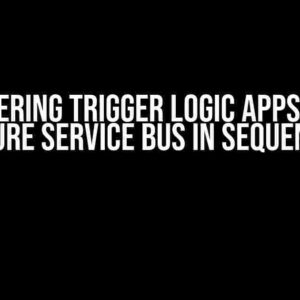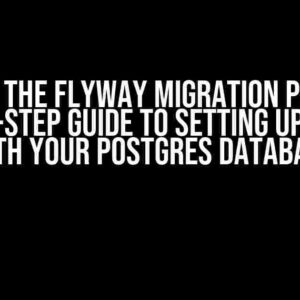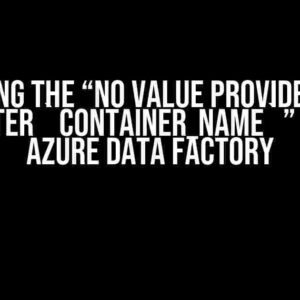Welcome to the world of Azure Logic Apps and Bicep! In this article, we’ll dive into the process of adding multiple workflows to standard Logic Apps using Bicep. If you’re new to Bicep, don’t worry – we’ll cover the basics before jumping into the nitty-gritty of multi-workflow configuration. By the end of this article, you’ll be a pro at designing and deploying complex Logic Apps with ease!
What is Bicep?
Bicep is an infrastructure-as-code (IaC) language that allows you to declare and deploy Azure resources. It’s a more readable and maintainable alternative to ARM templates, and it’s rapidly gaining popularity among Azure developers and architects. With Bicep, you can define and deploy your Azure infrastructure in a concise, modular, and reusable way.
Why Use Bicep with Logic Apps?
Logic Apps are a powerful tool for automating workflows and integrating with external services. However, as the complexity of your workflows grows, so does the complexity of your Logic App architecture. This is where Bicep comes in – by using Bicep to declare and deploy your Logic Apps, you can:
- Define your Logic App infrastructure as code, making it easier to version and manage
- Use modules and reusability to simplify your workflow definitions
- Take advantage of Bicep’s built-in validation and error handling
- Scale your Logic App infrastructure with ease, as your business needs grow
Adding Multiple Workflows to Standard Logic Apps through Bicep
Now that we’ve covered the basics, let’s dive into the main event – adding multiple workflows to standard Logic Apps using Bicep! We’ll break this process down into three steps:
Step 1: Define Your Logic App Resource
The first step is to define a Logic App resource using Bicep. This is where you’ll declare the basic properties of your Logic App, such as its name and location. Here’s an example:
“`bicep
resource logicApp ‘Microsoft.Logic/workflows@2019-05-01’ = {
name: ‘myLogicApp’
location: ‘West US’
tags: {
environment: ‘dev’
}
properties: {
state: ‘Enabled’
definition: {
// workflow definition goes here
}
}
}
“`
Note that the `definition` property is where you’ll define the workflow itself. We’ll get to that in a minute!
Step 2: Define Multiple Workflows
In this step, we’ll define multiple workflows within the same Logic App resource. You can do this by creating an array of workflow definitions and assigning it to the `definition` property. Here’s an example:
“`bicep
resource logicApp ‘Microsoft.Logic/workflows@2019-05-01’ = {
// …
properties: {
state: ‘Enabled’
definition: [
{
// workflow 1 definition
triggers: [
{
type: ‘Request’
kind: ‘Http’
inputs: {
method: ‘GET’
uri: ‘https://example.com/api/endpoint1’
}
}
]
actions: [
{
type: ‘Response’
kind: ‘Http’
inputs: {
statusCode: 200
body: ‘Hello, world!’
}
}
]
},
{
// workflow 2 definition
triggers: [
{
type: ‘Request’
kind: ‘Http’
inputs: {
method: ‘POST’
uri: ‘https://example.com/api/endpoint2’
}
}
]
actions: [
{
type: ‘Response’
kind: ‘Http’
inputs: {
statusCode: 201
body: ‘Created successfully!’
}
}
]
}
]
}
}
“`
In this example, we’ve defined two workflows within the same Logic App resource. Each workflow has its own trigger and action, but they share the same Logic App properties.
Step 3: Deploy Your Logic App
The final step is to deploy your Logic App using Bicep. You can do this using the Azure CLI or Azure PowerShell. Here’s an example using the Azure CLI:
“`bash
az deployment group create \
–resource-group myResourceGroup \
–template-file main.bicep \
–parameters.logicAppName=myLogicApp
“`
This command will deploy your Logic App to the specified resource group, using the `main.bicep` file as the template. Make sure to replace `myResourceGroup` and `myLogicApp` with your own values!
Tips and Tricks
Here are some additional tips and tricks to keep in mind when adding multiple workflows to standard Logic Apps through Bicep:
- Use modules to organize your workflow definitions and reuse them across multiple Logic Apps
- Take advantage of Bicep’s built-in functions, such as `concat` and `union`, to simplify your workflow definitions
- Use Azure Monitor and Log Analytics to monitor and troubleshoot your Logic Apps
- Use Azure AD and Azure RBAC to secure your Logic Apps and workflows
Conclusion
And there you have it – adding multiple workflows to standard Logic Apps through Bicep is a breeze! By following these steps and tips, you’ll be well on your way to designing and deploying complex Logic App architectures with ease. Remember to keep your workflow definitions modular, reusable, and well-organized, and don’t be afraid to experiment with new features and functionality.
Thanks for joining me on this journey into the world of Bicep and Logic Apps. If you have any questions or feedback, please don’t hesitate to reach out. Happy coding!
| Resources | Links |
|---|---|
| Bicep Documentation | https://docs.microsoft.com/en-us/azure/azure-resource-manager/bicep/ |
| Logic Apps Documentation | https://docs.microsoft.com/en-us/azure/logic-apps/ |
| Azure CLI Documentation | https://docs.microsoft.com/en-us/cli/azure/ |
| Azure PowerShell Documentation | https://docs.microsoft.com/en-us/powershell/azure/ |
// example.bicep
resource logicApp 'Microsoft.Logic/workflows@2019-05-01' = {
name: 'myLogicApp'
location: 'West US'
tags: {
environment: 'dev'
}
properties: {
state: 'Enabled'
definition: [
{
// workflow 1 definition
triggers: [
{
type: 'Request'
kind: 'Http'
inputs: {
method: 'GET'
uri: 'https://example.com/api/endpoint1'
}
}
]
actions: [
{
type: 'Response'
kind: 'Http'
inputs: {
statusCode: 200
body: 'Hello, world!'
}
}
]
},
{
// workflow 2 definition
triggers: [
{
type: 'Request'
kind: 'Http'
inputs: {
method: 'POST'
uri: 'https://example.com/api/endpoint2'
}
}
]
actions: [
{
type: 'Response'
kind: 'Http'
inputs: {
statusCode: 201
body: 'Created successfully!'
}
}
]
}
]
}
}
Frequently Asked Question
Got questions about adding multiple workflows to standard logic apps through Bicep? We’ve got answers!
Q1: Can I add multiple workflows to a single standard logic app using Bicep?
Yes, you can definitely add multiple workflows to a single standard logic app using Bicep! You can create multiple workflow resources within the same logic app resource, and Bicep will take care of the rest. Just make sure to give each workflow a unique name and define its triggers, actions, and other properties as needed.
Q2: How do I define multiple workflows in a single Bicep template?
Easy peasy! To define multiple workflows in a single Bicep template, you can use the `resource` keyword to create multiple `Microsoft.Logic/workflows` resources. For example, you can create two workflows like this: `resource workflow1 ‘Microsoft.Logic/workflows@version’ = { … }` and `resource workflow2 ‘Microsoft.Logic/workflows@version’ = { … }`. Just make sure to give each workflow a unique name and define its properties accordingly.
Q3: Can I use a loop to deploy multiple workflows in a single Bicep template?
Yes, you can use a loop to deploy multiple workflows in a single Bicep template! Bicep supports loops, which allow you to iterate over an array of values and create multiple resources. For example, you can create an array of workflow definitions and use a `for` loop to create each workflow resource. This can be super helpful if you need to deploy multiple workflows with similar configurations.
Q4: How do I reference multiple workflows in a single logic app using Bicep?
When you create multiple workflows in a single logic app using Bicep, you can reference each workflow using its unique name. For example, if you have two workflows named `workflow1` and `workflow2`, you can reference them in your logic app resource like this: `resource logicApp ‘Microsoft.Logic.logicApps@version’ = { workflows: [ workflow1, workflow2 ] }`. This tells Bicep to create a logic app that contains both workflows.
Q5: Are there any gotchas I should watch out for when adding multiple workflows to a standard logic app using Bicep?
Yes, there are a few gotchas to keep in mind! One important thing to note is that each workflow must have a unique name, so make sure to use unique names for each workflow. Additionally, if you’re using a loop to deploy multiple workflows, make sure to use the `dependsOn` property to ensure that each workflow is deployed in the correct order. Finally, double-check that you’re using the correct API version and that your Bicep template is formatted correctly to avoid any deployment errors.





